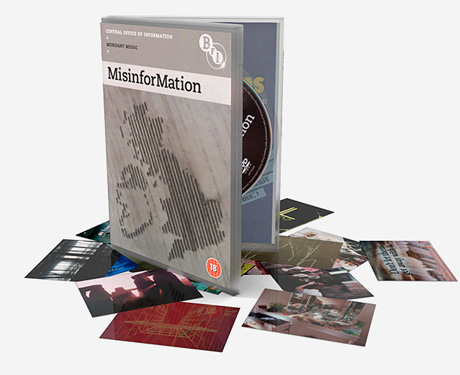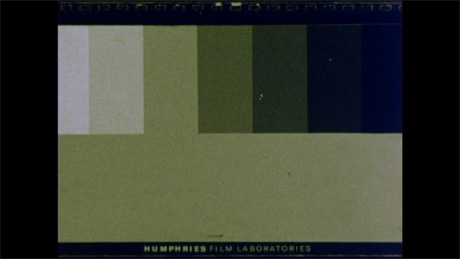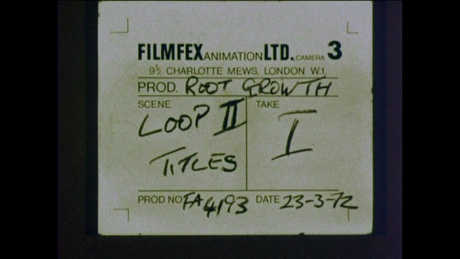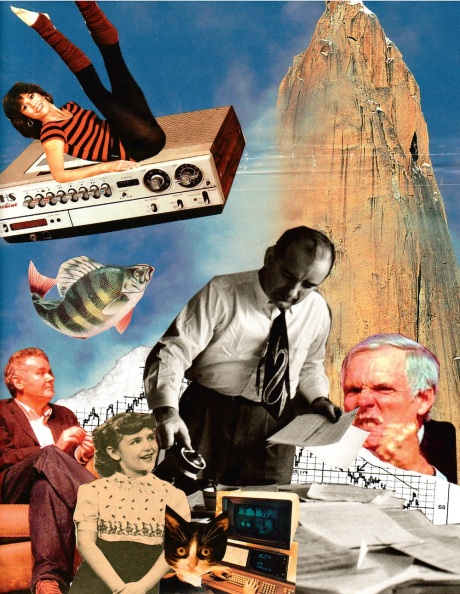
The first time I watched this DVD I was pretty stoned. One of my favourite pastimes is to put on a film, one with great pictures and no dialogue such as Koyaanisqatsi, or some old Buster Keaton movies, skin up a large one, and provide my own soundtrack to the visuals out of my sizable collection of electronic music. As the psychotropic compound hits the cannabinoid receptors in the back of my brain and takes hold, pictures and sounds become one, rhythm becomes serendipitous, and my senses and imagination work together to re-contextualise this information in any way they see fit.
Intracellular signal transduction pathways are activated! I drift off into my own reverie, the images become blurred, the sound becomes muffled, and I pass out on my bean-bag, fully satisfied by this waking dream. With MisinforMation it feels like the Baron Mordant has done much the same thing, except he has managed to stay conscious long enough to write some original music, bespoke for the occasion.
I decided to watch the DVD again, this time with a clear head. The box doesn’t give you much information to be misguided by, though I’ve now worked out that the DVD is a collaboration between the BFI and Mordant Music, edited and re-scored by the latter, using the former’s access to the archives of the Central Office of Information – the UK government’s marketing and communications agency, and producer of public information films.

Pressing play you are greeted with a stark looking menu with the cryptic option to view “Spools” or to “Spore All” – I chose the latter. You are flung head-first into a Hitchcockian nightmare-vision of invading magpies, which quickly reveals itself to be a crime prevention commercial, extolling the virtues of Neighbourhood Watch. The sound is synthetic and ominous, the mood disquieting. This sets the tone if not the main themes of MisinforMation from the outset, a work that is as interested in the mechanics and language of film, as it is with the content. Indeed, the frequent use of test cards, countdowns and grainy damaged reels, conveys a love for the textural quality of the medium, and how that can effect the mood and feel of the images, as much as the themes and narratives displayed therein.
The Baron Mordant’s score emphasises this devil in the ambiguous detail. It is his music which becomes the constant thread, tying disparate pieces together. As many of the visual sources are from the 1970s and 80s, the nods to Vangelis and Eno seem highly appropriate – but it isn’t another retro pastiche. The sounds are pulled apart and elongated to form textures and drones. While at times it is Hauntological in the manner of Ghost Box or Boards of Canada, often the synths and effects are more akin to Autechre or Merzbow, noise and ambience are intense and lift the images to another plane. All works well until the Baron attempts a song – a somewhat naive blip on an otherwise flawless electronic score.
All the short films collated here are highly watchable, and interesting historical objects in their own right – but in MisinforMation they are re-purposed, obfuscated and altered – the new interpretation provided by sound alone. They are shown in a new light and this has a big impact on their semantic purpose. This is the main concept behind the project – that with only slight deviations from the original context, the meaning can be completely transformed. Sometimes this works better than others.






A Dark Social Template is particularly effective. The new soundtrack casts a bleak re-imagining of our past’s visions for the future, playing on our informed position of knowing exactly how certain ideas would end up failing. The concrete mazes and dungeons of 1960s new builds are underscored by itchy, nervous, analogue bleeps and tones, highlighting the inhumanity of such places – while the original film, blissfully unaware of their future failure, tries to persuade poor sods to up-sticks and move there. Animated sections in the film are rendered surreal, with human behaviour made to look alien and viral, cities emerge like infected wounds on the earth’s skin. A beat-less disco makes the revelers look like absurd maniacs and re-interprets an OAP’s conga-line as some bizarre satanic ritual. The only part of this piece that didn’t capture my imagination was watching the presenters talking without the original audio. It was as if I had turned the sound down on my own TV, and this made it feel a bit amateurish when compared with the perfect wedding of music to picture in the other scenes. This is executed better, later on, by replacing the original voice with another – a much more interesting use of such footage, and more befitting of the title.
Attenuated Shadows is another highlight. This short film about solvent abuse would have been profoundly disturbing without the new score, but the music here goes really well indeed – mournful chords and woozy soundscapes add melancholy to the shock value. The footage looks very real, and yet we’re told at the end of the documentary that the children depicted doing glue, did not inhale. This seems hard to believe – were the COI covering their arses for fear of being labeled exploitative? Was the original misinforming us, or has Mordant Music’s emotive scoring misinformed us into believing the illusion? Maybe we’ll never know. This is MISinformation after all.
Urban nightmares are then replaced by grainy pictures of Stone Henge and picture-book illustrations of early man. Ridyll was the weakest section for me. It didn’t feel as though it had been re-purposed as much as the others, and it did drag a little. However, it does benefit from being an interlude, and in contrast with the other more intense offerings, it paints a quaint picture of Britain’s ancient history. And the music is pretty good too, featuring a Moog wig-out in the style of Bo Hansson.
Elsewhere on the DVD we see the famous AIDS advert (from the 80s) in reverse, a suburban domestic version of Tron where nature fights back, a documentary on Ink Jet technology repurposed to reveal something dark in our nature, strange footage of nematode worms in a lab, and many other more abstract pieces, where music and visual mesh perfectly with no apparent agenda or message to be conveyed. The last film is pure audio-visual pleasure, as beautiful images of the sea and coastline are immaculately scored – the sound and picture relationship here is more precise than anywhere else in the work, with beautiful rhythmic editing and a sense of humour to boot.
In conclusion then, I simply can’t recommend this DVD enough – it is a work of art with very few aspects in need of criticism. It is both thought-provoking, emotive and intelligently complied. What I would say though, is that it is best viewed instinctively, on psychotropics, so your own imagination becomes part of the work, and you get lost in the minutae and subtle inter-relationships that jump-start old memories and lateral ideas. You get lost in it happily. Watched in a sober, more linear fashion, you end up trying to second-guess the creator’s motivations, and I don’t think you get quite as much out of it that way.
Best served with 3.5 grams of “Blue Cheese”.
You can buy the DVD from Boomkat
June 14, 2011
Categories: Art, Documentary, Drugs, Film, History, Music, Review . Tags: BFI, documentary, Experimental, Hauntology, Misinformation, mordant music . Author: Micolagist . Comments: 10 Comments














